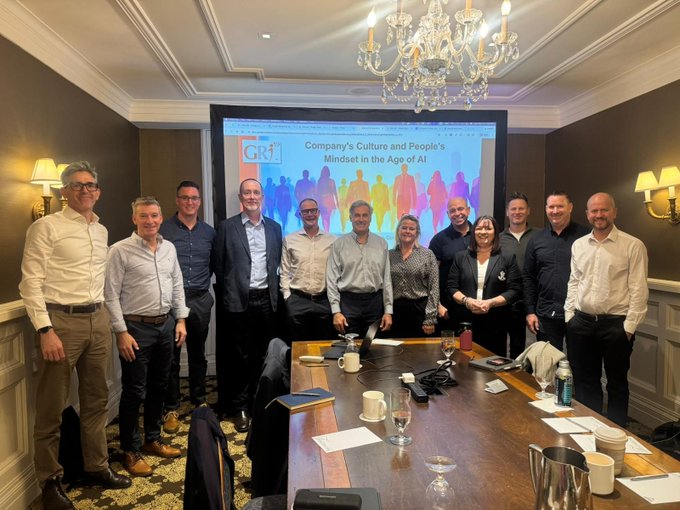What Part of 'Quiet Hiring' Don't You Understand?
Posted by Frederic Lucas-Conwell

What Part of “Quiet Hiring” Don't You Understand?
Several trends have recently gained traction in the workplace, and “quiet hiring” is one of them.
If you are unfamiliar with it, “Quiet hiring" describes a company's filling job openings with current employees without publicizing any vacancy. Additionally, this term is used when a company faces a workload increase, requiring employees to expand their roles, enhance their existing skills, or assume new responsibilities, thus “hiring” them beyond the original contract.
It follows another trend of “quiet quitting” that emerged in 2021 with the silent disengagement of employees and a reluctance to go above and beyond. We also heard about “quiet firing,” when an employee is terminated without being given a reason.
As the image above illustrates, what happens quietly may come from various sources, within us, and from our relatives, especially now that much happens remotely with increasing complexity, whether at home or work.
Can we do anything differently today to turn those quiet decisions, whether quitting or hiring, into positives?
It’s worth watching TicToc, YouTube, or Instagram on the topic (but please come back here once you have done so). The clips tell in color how the “quiet” trends emerged, showing skepticism and concern about the workplace and its management, especially from younger generations. Is quiet hiring another way for employers to exploit employees? May employees not be compensated for their extra work? Worries go on.
From an organizational standpoint, there is nothing really new about the “quiet” trends, except the new labels. It still calls for better management and much that should come with it: better communication, more transparency, a positive coaching attitude, and being proactive with more creative solutions for facing the new challenges of the workplace, especially with those entering into it.
Ultimately, quiet hiring and other “quiets” can be seen as an opportunity for leaders who aspire to build a resilient organization, and employees interested in thriving in the workplace.
Reframing the Challenge
The scarcity of face-to-face interactions, the rise of hybrid work as a new standard, and the blurred boundaries between home and work have all contributed to fuel an alarming situation in employee engagement, at a low 22% in 2019, and continuing even lower at 21% in 2021. These numbers should compel leadership to actively and "quietly" re-engage, re-hire, and recognize “quiet hiring” as a significant aspect of their role.
Consider the case of Amanda, newly hired as the head of marketing at a SaaS company in the summer of 2022. She inherited a team of a dozen. The company has a diverse workforce based in the USA, Europe, and South America. An articulated vision, properly funded in series D. The company looks promising and thriving. It is on a growth trajectory, recruiting and investing in its people, and carefully so, not overspending on perks; a recession may come; every penny counts.
One of Amanda’s team members, Logan, was showing increasing signs of quiet quitting: emails answered later, a few negative comments here and there, less participation and a less happy face during meetings; an increasingly neutral attitude with colleagues; delivering the minimum just in time.
However, the workload for Amanda’s team continues to increase: new clients, more outreach initiatives to start, and new assignments for the team members. At the same time, generative AI is transforming everyone’s job. There is the opportunity for all to grow, learn new tasks, and be quietly hired for them.
Is Logan’s case too desperate to adjust his job’s assignment, and discuss the new tasks? What’s happening with him today anyway? What should Amanda do? High costs associated with talent development have always made engaging and retaining the best employees challenging across all levels. However, the crucial difference now is that talented individuals like Logan may progressively quietly disengage from, or not give their best at, work, without you even noticing it as their leader, or them clearly realizing what negatively affects their morale.
The “Quiet” Space
As organizations and employees become more accustomed to grappling with this new phenomenon of quiet hiring and other quiets, the word "quiet" is paramount. Let’s dig into what “quiet” refers to in these expressions. "Quiet" encapsulates what happens up there in our mind with our brain muscles and circuitry, and how the environment influences them. How we are driven to think “under the hood” ends up in how we act.
We need to go back to the days of behavioral research in the 1940s, to read about the importance of covert and overt behaviors. After a few years of radical behaviorism, scientists were investigating our cognition and personal constructs in the 1950s, while personality research was progressively identifying a limited number of factors to describe our behaviors, either coming from within or being observed from outside. For more than three decades, novel techniques in neuroscience have brought new insights into the complexity of our covert (internal) processes and how they relate to emotions.
Emerging in the 1990s, the behavior-factor-based approach we use at GRI uncovers what drives us to act from within and outside. What are our intrinsic motivations and engagement from a behavioral standpoint? How do we build trust and perform as a team? How do we communicate, make decisions, and solve issues? How we think and act — as informed by behavior factors — can tell.
With remote work and fewer face-to-face occasions to understand what’s quietly going on, this “quiet data” is even more relevant today to foster better-informed conversations between employees and their managers. The "quiet" space holds value in comprehending other organizational aspects that quietly happen as well, such as "quiet interviewing," "quiet onboarding," "quiet building trusted connections," “quiet communicating,” “quiet building team,” “quiet motivation," or "quiet coaching."
Better Informed Discussions
An employee has many reasons to “quietly quit.” It’s easy to jump to conclusions and invoke incompetence or inappropriate attitudes, blame the previous manager, even the HR employee who participated in the recruiting, or a coach who intervened.
For Amanda, as a new manager, building trust, and growing leadership takes time. Making a faux pas is usual when managing situations such as Logan’s. A discussion with the Founder and the HRD involved in hiring Logan reveals that when Logan started his job, right before Covid, his experience, attitudes, and delivery were at par with the expectations. He started to underperform before Amanda started when everyone in marketing reported to the founder, but his underperformance has accelerated since then.
In any case, Amanda inherited the situation, and it’s now part of her job to do her best to find a solution for Logan. This typically requires management to make the first move.
Most employees work remotely in different time zones at this company. They rarely meet in person. After six months in her new job, Amanda organized an offsite for her team in Europe. Logan was the only one who didn't attend.
However, the organization was using the behavior-factor-based approach, which provided Amanda with the information she needed to power the conversation with Logan and shift gears from “quiet quitting” and “quiet firing” to “quiet hiring.”
When recruiting, you may not immediately see the value people hold and what could be done to unleash their potential. It happens similarly with “quiet hiring.” The challenge of reaching that “quiet place” of covert behavior, where you find what makes your people tick, is the same. There is much there that triggers us to communicate, understand our relations at and outside work, rationalization, worry, and more.
Once uncovered, this “quiet space” invites managers and employees alike to improve their relationship. As we continue to see with the factor-based approach, this comes in short, at improving performance and well-being.
For Amanda and Logan, it helped to compare their styles and understand more objectively the individual needs and the needs of their organization. They discovered that there was a misalignment that could be solved. Logan realized that he needed to re-organize his work from home, clarify the benefits of group discussions, and see Amanda as a resource rather than a competitor for a position he was not ready to take anyway.
It all required space for dialogue, and better-informed discussion from what quietly happens, which clarified how the employee and management contract could be continued and enriched for better performance.
Quiet Learning
Turnover harms the business by losing people with strong knowledge and commitment. If you are short on talent, rather than letting “quiet quitting” affect the company negatively, you are compelled to create greater effectiveness among your human resources. This requires uncovering their hidden strengths and helping them flourish in their job by continuously “quiet hiring” wisely, with attention to how it benefits both the employee and the organization.
It may feel like there is never time to work on and learn about the interpersonal elements, and that is where you need actionable data about your people that shows how they are likely to be the most effective and engaged. Learning about people never ends. Moreover, as for hiring, learning is always quietly happening. This quiet learning needs quality data to happen effectively.
When you understand how well a person functions, you can put their preferences and abilities to the best use, while also making sure they feel appreciated, and making a difference. This is an ongoing process that needs to be accelerated and objectified.
“Quiet hiring” is certainly not a new concept, but as the pace of change and upheaval in workplaces increase, and uncertainty and fear around automation ramps up, it becomes critical to make it a positive experience if you want to keep your people engaged and thriving.
Once you know more about what quietly happens that you couldn’t see, hopefully, it prompts you to continue to think, learn and do something about it.
About Growth Resources Institute
The GRI is the ideal tool to assist you in creating positive “quiet hiring” and other “quiet” experiences, giving you actionable data about your people, your teams, and your positions so that you can keep up with the current pace of change, and meet industry challenges head-on.
Please contact us today at contact@gri.co to learn more about how the GRI can work for you and your company. To receive our newsletter, subscribe here.
The article was written by Frederic Lucas-Conwell, with editorial work from Nicole Phelon, following a GRI forum on quiet hiring. Particular thanks to Mihai Moghior, André Lit, and Kristina Tyler for their covert and overt behavior input to the discussion.
Frederic Lucas-Conwell is CEO & Co-Founder of GRI – the Growth Resources Institute. Frederic is an author, researcher, speaker, and serial entrepreneur for the last 35 years. He has consulted for Fortune 500, privately-held companies, and startups, in leadership and organizational development. Frederic holds a Ph.D.in Organizational Behavior from Paris Dauphine University - PSL.
References
Kelly, G. A. (1955). A Theory of Personality: The Psychology of Personal Constructs. W. W. Norton & Company, NY. For a deep dive into personality from a cognitive standpoint.
McRae, E. R. Why (2023) Quiet Hiring is a Win-Win for Employers and Employees, Gartner.
Sapolsky R. M. (2017). Behave: The Biology of Humans at Our Best and Worst. Penguin Press, NY.
Tourinho, E. Z. (2006). On the distinction between private events and the physiology of the organism.The Behavior Analyst Today, 7(4), 548–559. https://doi.org/10.1037/h0100097. For a discussion about covert behaviors.
State of the Global Workplace: 2022 report. Gallup. For most recent data about engagement in the workplace.
Latest Articles
Groupama Successful Transformation in Romania: The GRI, Catalyst for Profound Change
The history of Groupama in Romania is an eloquent testament to resilience, strategic vision, and the transformative impact of innovative management tools. Arriving at the...
Hybrid Work: A Management Revolution
The COVID-19 pandemic has acted as an unprecedented catalyst, radically transforming our approach to work. What was once a marginal practice has become the norm for many...
Leadership 3.0: Objective Insights for People-Centric Leaders
Steve, a brilliant entrepreneur, poured his heart into his work. His team at "Innovatech" was on the brink of a major breakthrough, a new app that promised to revolutionize...



